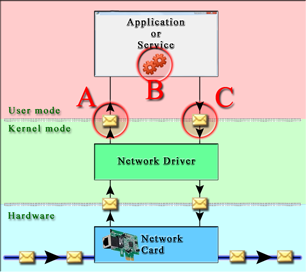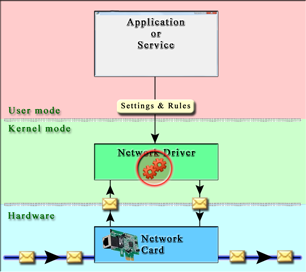Our Technology
The network communications industry has many technologies that support and improve communication over various networks.
Our technology brings security with numerous network optimizations into the mix.
The technology is a device driver framework that implements a concept of man-in-the-middle (MITM) TCP/IP stack.
It is a TCP/IP networking stack built from the ground up specifically for the purposes of security and optimizations.
It allows parties of network conversations to communicate transparently without noticing that optimizations and security checks are taking place.
The framework supports many currently popular network protocols and performs programmable operations within the heart of the operating system - within device drivers.
Modern security frameworks implement security analysis within the application space by requiring applications either to link or to load modules that perform certain functions.
In contrast, our technology operates transparently within the operating system and does not require any modifications to legacy software.
It can be installed and updated independently of applications.
The overhead of other security frameworks due to operations within the application space could substantial.
Therefore, the advantages of using our technology are easy to notice:
- Faster performance, since device drivers operate at higher priorities than application space programs.
- Better performance due to memory optimizations. There are no unnecessary transfers of memory blocks back and forth between the OS and applications.
- Early detection and filtering out of suspicious activities and their removal from network conversations.
- There are no additional requirements for applications to use specific technologies or to link to specific libraries.
- Easy to upgrade and virtually no compatibility conflicts.
Other security frameworks
|
Verigio framework
|
 |
 |
On the above diagram, red circles with letters indicate
inefficiencies the other frameworks are suffering from.
Those inefficiencies waste CPU time and reduce performance
of the whole computer, not only its networking subsystem. Their
impact on performance can be summarized as follows:
(A) and
(C) Kernel-mode to user-mode transition.
- [CPU, MEMORY] Allocation and copying of memory during data transfer between kernel-mode and user-mode for every packet.
- [CPU] Serialization of data transfer. This voids the benefits of multi-core processors.
- [CPU] Overhead of switching from kernel-mode to user-mode.
(B) User-mode traffic processing.
- [CPU] User-mode traffic processing is executed on user-mode threads that compete for CPU with other applications.
- [CPU,MEMORY] Possibility of memory being paged out into a page file.
- [CPU,MEMORY] Queuing of data caused by processing slower than incoming from kernel-mode data.
Just like other security frameworks, our framework can work fully within the application space as well.
But a lot more benefits come from its use within device drivers. That is something the other frameworks can not easily match.
With the precise implementation of optimizations of common processing bottlenecks, our framework allows to get the most out of the existing hardware and VMs.